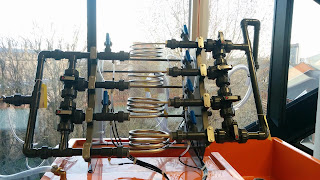Over the past six year, the Department of Multidisciplinary Engineering Education has been telling anyone that wants to listen, and a few people that don’t, about the advantages of our collaborative approach to delivering lab based teaching.
One of the logistical benefits comes from a chain of effects: If you pool resources you can buy (or make) multiple copies of equipment -> this allows large cohorts to complete activists in a shorter window of time -> so all students do labs in the same order -> and you can generate a more deliberately progressive curriculum. There are lots of others and these are now well published.
These advantages were always part of the plan and the justification for opening and resourcing the department. But I find it joyful when, six years on, I’m still finding unexpected advantages in our model of operation that I’d not considered before.
In the fluids Engineering lab, we have 10 copies of a “network of pipes” apparatus. Typically we have 20 copies of each experiment. We have 20 hydraulic benches, which are like splashy workstations onto which we can place fluids experiments like this, but these rigs are absolute monsters. They take up a disproportionate amount of our storage space compared to our other apparatus and it is a two person job to lift and manoeuvre them into place for students to work on. So we only have 10. Because we like building stuff, we have the benches and we like teaching lots of students simultaneously, we are considering how we could manufacture more copies of the apparatus, but without the faff.
One of the reasons the equipment is so cumbersome is because it is highly configurable. There are several chunky 3-way valves that allow the students to set up different branching paths for the fluid to flow down and heavy duty connectors that allow pipes of different diameters to be swapped in and out easily but without leaking. The manufacturers almost certainly envisaged that a University would buy one or two copies of this equipment and students would stand in front of it and run a range of scenarios so that the activity was suitably rich and investigative. We were considering how to replicate this experiment, when we had our epiphany.
Because we are planning on building 20 rigs, we can create 20 different fixed configurations, and allow students to circulate between them. This will provide the options of experimenting with a variety of scenarios without the overhead of figuring out how to make each rig configurable.
This may not be an innovation that changes the world, but it is another benefit to add to the lists that demonstrate the model we adopt is valuable.
